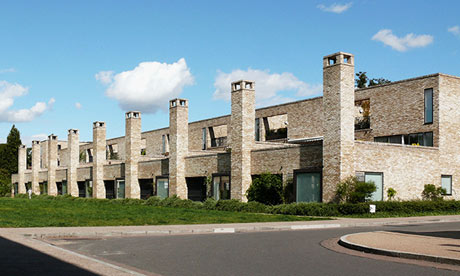Submitted by WA Contents
I’m in a Stirling prize winner … get me out of here!
United Kingdom Architecture News - Oct 01, 2013 - 13:40 7126 views
It is the most coveted award in British architecture. But what's it like to live or work in a building that won it? Our critic uncovers a story of leaky roofs, sweltering space-bubbles, windows that won't open – and playgrounds you can't play in

2005 Stirling prize winner, the Scottish parliament in Edinburgh: its long facade now has a blocky security entrance tacked on. Photograph: Murdo Macleod
'The definition of an architect," said an exasperated Lord Blake, provost of Queen's College, Oxford, on the completion of the long-delayed, over-budget, leaky-roofed Florey student accommodation building, "is someone you employ only once."
It was 1971 and the architect in question was James Stirling, the uncompromisingly brilliant bulldog of British postmodernism, whose name now presides over the most coveted annual prize in architecture – to be awarded by the Royal Institute of British Architects on Thursday night. The trauma of Oxford's encounter with what Blake described as Stirling's "incompetence, dilatoriness, casualness and general inefficiency" was enough to make it difficult for the Glasgow-born architect to build in this country for the next 20 years. Visiting some of the buildings that have since been bestowed with the precious Stirling prize, it seems some of their users and clients might sympathise with Blake.
Writhing at the bottom of Arthur's Seat in Edinburgh, in a tangled collision of granite, concrete and splintered wooden shards, the £414m Scottish parliament is one of the most striking buildings to have been given the gong – and also one of the most contentious. Designed byCatalan architect Enric Miralles, winner in 2005 after his death, it was lauded by judge Piers Gough as a work of "poetry, beauty, magnificence" – and by land artist Charles Jencks as "an icon of the organic resolution of nature and culture". But – finished three years late, at 10 times the original budget and subject to a public inquiry – it was a decision that was hard to swallow for many. Eight years on, has the project proved its worth?
"It certainly deserves a prize," says politician Margo MacDonald, independent MSP for Lothian, "for being the most energy-inefficient building in Scotland." Energy performance is just one of the items on the building's long list of functional failures: a great beam fell down in the main chamber soon after completion, doors buckled, windows cracked, the roof started leaking – and a flock of pigeons took up residence.
"It just doesn't work nearly as well as it should for that amount of money," says MacDonald, who prefers to watch debates on TV because the acoustics are so bad in the chamber and the microphones are in the wrong place. She has converted her "think pod" – the trademark wonky cubby-holes that project from the building's facade – into a storage space. "They're a ridiculous idea," she says. "Far too uncomfortable to sit in – and you bang your nut when you try to get in."
Such practical considerations have not deterred the crowds: the building receives 400,000 visitors a year, running a close second to Edinburgh castle – although with such exposure comes increased threat. On the advice of counterterrorism officers, a vast granite and glass pavilion appeared at the entrance to the complex last month, a £6.5m bunker through which visitors are now funnelled.
"It has completely destroyed the entrance sequence," says John Kinsley, the project architect of the original. "The fundamental idea was about the building's relationship with the landscape, the view you get on arrival through to the crags beyond. Now that's been completely destroyed by plonking this thing in the middle."
The parliament is not alone in suffering contentious alterations. Earlier this year, the Architects' Journal reported that Accordia, a model housingscheme in Cambridge that won the Stirling prize in 2008, had become a site of a "class war" over a series of controversial home improvements. Trouble began stirring in this leafy idyll when some residents in the social housing units applied wood stain to the cedar boarding of their porches – timber that had been intended by the architects to fade to a silvery grey.
"It subverted the unity of the overall design," says resident Robert Parkinson, who works as a conservation architect for English Heritage. "Broadly, I'm quite liberal about places changing over time, but some of the additions here have been rather undesirable."
"The place is vulnerable," says Robert Lowson, of the residents association, "because its look depends on the uniformity of the features. Once they start to change, that degrades the visual impact."
When two new car ports appeared and one property's upper deck was converted into an additional room, residents of the million-pound houses got together and launched a campaign to have the entire development designated a conservation area. This was granted in June – an unprecedented step for a project only five years old.
"Accordia does have a coherence," said Tim Ward, Cambridge's executive councillor for housing, "which we wouldn't want to see ruined by ramshackle extensions here and there."

Accordia housing scheme, Cambridge, the 2008 winner: now a conservation area, to deter home improvements.
The broader urban setting of Stirling prize-winning buildings is rarely discussed in either the judging process or the immediate aftermath, each project crisply severed from its surroundings for the purpose of assessment, all context conveniently cut out of the photographer's lens. But bestowing the award on a building can have ripples, inevitably influencing what comes next – perhaps nowhere more so than in Deptford, south-east London.
The Laban Centre, by Swiss architects Herzog and de Meuron, won the prize 10 years ago. Named after dance pioneer Rudolf Laban, this school of contemporary dance was, said the judges, an "extraordinarily fine building that raises the expectations of architecture". Colourful and transparent, the centre shimmered out of the evocative post-industrial wastes of Deptford Creek like an ethereal jewel.
Visit today and you're in for a shock. The building itself is much as it was – and has weathered particularly well, given it is clad in plastic sheeting. But looming over, above and all round it is a frightening Frankenstein-like big brother. Creekside Village is the work of Squire and Partners, who say their muscular glassy blocks "express the patterns formed by a dancer, using the system of notation pioneered by Rudolf Laban". Funny that – this is exactly what the premise of the Laban Centre was. Similarly, the subtle chameleonic colouring that shimmers in greens and yellows behind Herzog and de Meuron's facade has been ham-fistedly slapped across the glass walls of the towers, giving them the look of great jaundiced giants.
"It's flattering to be a source of inspiration," says Anthony Bowne, principal of Trinity Laban. "And it's good that we kickstarted the regeneration of the area. But the new architecture is of mixed quality."
It may still look pristine, but wandering the corridors of the Laban is a different thing to studying there. "It is a great facility," says May-Lee Hollis, who trained there for three years. "But when you're here all day every day, it can get a bit much. The architects were keen on transparency, but it can be like being in a goldfish bowl, being watched all the time. There's nowhere you can't be seen apart from the toilets. It's also annoying that none of the windows open, as you get so hot dancing."

Lord's media centre, 1999 Stirling prize winner: cricket commentators found it too bright and hot to work in. Photograph: Mike Hewitt/Getty Images
Stuffiness also plagued the Lord's media centre. The space-age bubble at the London cricket ground landed the prize in 1999, but soon had to be adapted because it proved too bright and too hot. Veteran test-match commentator Christopher Martin-Jenkins declared the building a failure: "You don't get a proper sense of what's happening," he said in 2002. "And it's so bright you can't see your laptop."
More recently, both of Zaha Hadid's Stirling winners have proved troublesome. The £133m Maxxi contemporary art centre in Rome, which won in 2010, went into administration last year. Its swooping matrix of intersecting concrete "flow lines" provide endless amounts of thrilling circulation, but very little usable gallery space on its dynamic, tilting walls. It has since been saved, but continues to confound curators in search of a right-angle.
A year later, the queen of the curve took the prize once again, for a hedge-fund sponsored academy school in Brixton. Looking more like one of its patron's luxury power yachts than an inner-city London comprehensive, the Evelyn Grace Academy is all billowing concrete flanks, sun decks and tinted windows, bisected by a bright red running track. The playground is dotted with jagged concrete benches, following yet more dynamic flow lines. But when I visited, the principal told me the area was off limits: the benches were too sharp to allow children to play near them.
From sparking class warfare to changing the nature of an entire neighbourhood, the Stirling prize perhaps has more power than it knows. When the judges convene on Thursday night, let's hope they wield that power wisely.
> via TheGuardian
